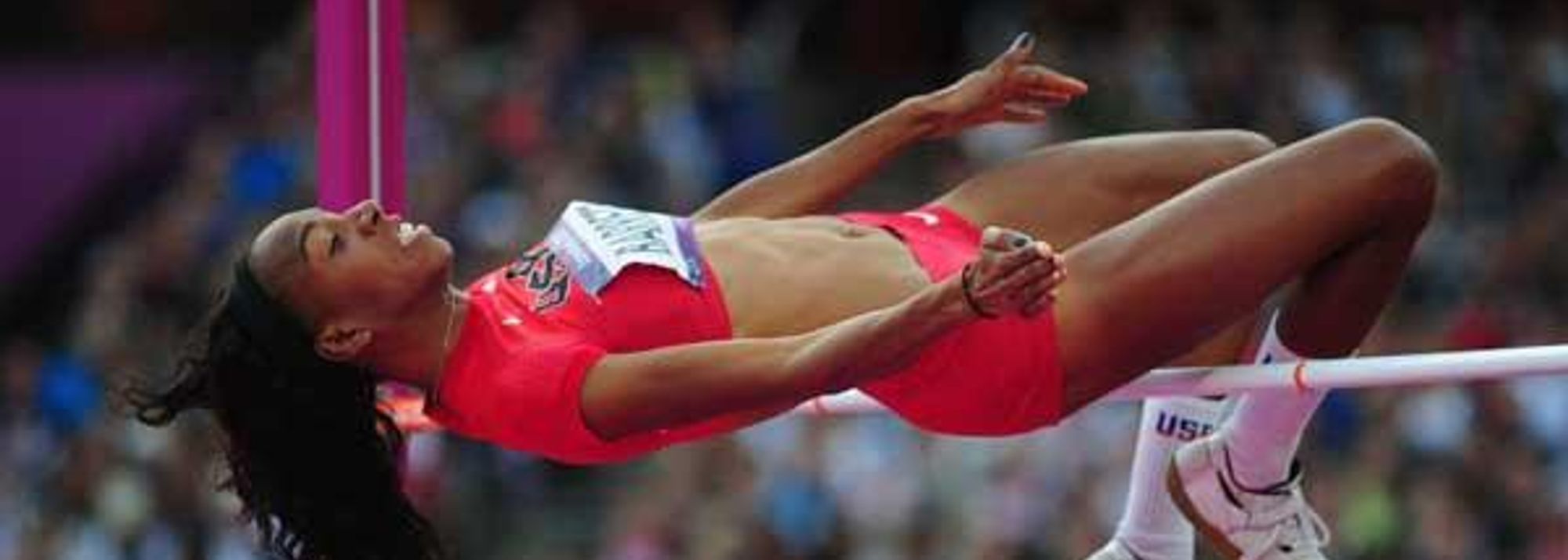Brigetta Barrett (© Getty Images)
The first question you ask Brigetta Barrett is not about her Olympic high jump silver medal from London this year. You don’t ask her either about clearing a World record that some elite former jumpers have prophesied will happen during her career. The first question you ask Brigetta Barrett is: “How was homecoming?”
Barrett, 21, may be thinking about all those other things – how can she not after an amazing year that saw her emerge from relative obscurity to standing on an Olympic podium in one summer? – but right now she’s also still a student in her final year at the University of Arizona, and in November she was elected as the homecoming queen of her 30,000-person college.
So you ask her what it’s like to come home.
Long road home
The tradition of homecoming in US universities dates back to early last century. It’s a celebration to welcome returning university alumni ‘home’, the queen and king are elected by their classmates to represent the best and brightest of their peer group, the epitome of what it means to be a student at that institution.
They are the ceremonial bald eagles on top of a very tall flagpole.
Winning an Olympic silver medal and being elected homecoming queen are seemingly wildly disparate accomplishments. The former is based on the black-and-white reality of throwing your body higher than the girls to your left and right. The other is more about the grey world of politicking, smiling big and dressing nice.
But both require transcending strata and, for Barrett, this past year has been all about moving through the ranks.
In 2012, Barrett was vetted firstly through the NCAA university season, defending her 2011 collegiate titles both indoors and outdoors, a feat no one else has ever achieved in the highly competitive American system. She then went to the US Olympic Trials in Eugene and finished as the runner-up to the US record-holder Chaunté Lowe.
Barrett showed plenty of her competitive mettle at the track that will stage the IAAF World Junior Championships in two years' time, when she improved her personal best twice, to 1.98m and then 2.01m.
Barrett eschewed any further outings before the Olympics but once there she surprised many pundits to beat all but one of her rivals, the Russian winner Anna Chicherova, clearing another personal best of 2.03m.
Surprise package
Barrett knows what she did this year is seen by many as surprising.
“The world wasn’t paying attention to American female high jumpers,” she said. “They weren’t expecting us to get it done because we haven’t got it done in over 20 years.”
Lowe may have won at the IAAF World Indoor Championships earlier this year, but no US female high jumper has won at a global championship outdoors since Louise Ritter’s victory at the 1988 Olympic Games in Seoul, more than two years before Barrett was born. In fact, the only other US medal in the event at an Olympic Games or World Championships, between Ritter’s gold and Barrett’s silver, was when Lowe finished second at the 2005 World Championships.
“I like that nobody was expecting me to win a medal,” added Barrett. “And honestly, nobody kept that a secret. Even the girls, the other Olympians, they’re like, ‘Yeah, you’re young. Nobody expects you to win a medal.’ I remember one person told me, ‘You’re here for fun, and we’re out here thinking about how we’ll eat.'
"In my mind, I was like, 'OK, I understand what you’re talking about but, at the same time, I’m hungry, too.' It doesn’t matter if I’m trying to feed a family or not; I’m still going to go out there and take what’s mine. We play to win the game.
“I was like, man, I trained for this. This is something I’ve been intentionally working toward most of my life. I deserve this.”
Tall order to be homecoming queen
Barrett provides the details of her bid to become the homecoming queen; it has parallels to her 2012 athletics season.
After the nomination from her school’s athletics department, she went through the series of interviews and formal mixers where everyone acts really nice and speaks in hushed tones.“My whole mentality going in [became] if I’m going do this, I’m going to be myself the whole way through. So I didn’t wear a dress; I wore a nice blazer.”
She made it to the semifinals and then into the finals, called the homecoming court, where she campaigned for herself in what she describes as “a new world".
Barrett had never been part of the homecoming tradition before, she says she’d never been the ‘popular girl’, and said that she’s never been considered pretty. Instead, she was the tall one (Barrett stands 1.83m) and the skinniest girl in her class. The very things that have made her such an excellent high jumper had been her greatest shames.
However, her pursuit of becoming the homecoming queen was like her pursuit of an Olympic medal. Barrett was growing comfortable with herself, and her timing was perfect. “The closer it got to the day we found out [who won homecoming queen], my competitive side definitely full-force came out, and I was like, ‘No, I definitely want to win this thing',” said Barrett.
Her charisma was addictive. More and more people – many not involved in sports – found themselves captivated by Barrett and took to social media in support of her.
Barrett won an Olympic silver in August and three months later she made history to become her university’s first black homecoming queen.
“It’s funny where you start and where you end up,” said Barrett, who turned 22 on Christmas Eve, perhaps also thinking also about the journey that took her from her home in the small New York state town of Wappingers Falls across the United States to the University of Arizona. You could say Barrett is home.
Jon Gugala for the IAAF





